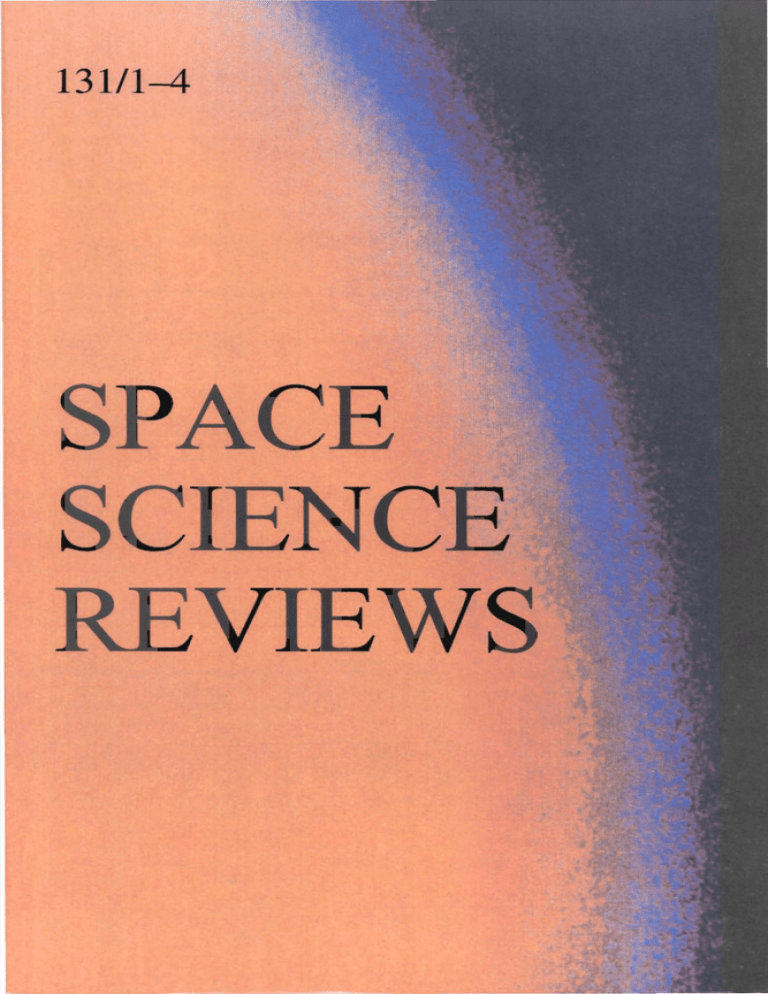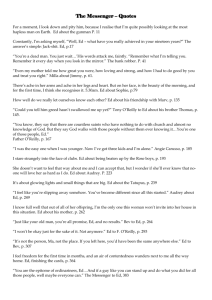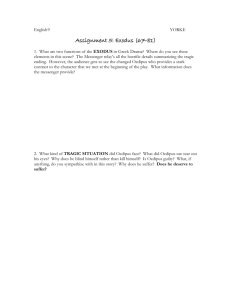Document 10578259
advertisement

131/1-4 Space Science Reviews Volume 131· Numbers 1-4· August.2007 The MESSENGER Mission to Mercury Guest Editors: D.L. Domingue and C.T. Russell Foreword D.L. Domingue· c.T. Russell 1 MESSENGER Mission Overview s.c. Solomon· R.L. McNutt· R.E. Gold· D.L. Domingue 3 The Geology of Mercury: The View Prior to the MESSENGER Mission J.W Head· C.R. Chapman· D.L. Domingue· S.E. Hawkins· WE. McClintock· S.L. Murchie· L.M. Prockter· M.S. Robinson· R.G. Strom' T.R Watters 41 MESSENGER and the Chemistry of Mercury's Surface Wv. Boynton· A.L. Sprague· S.c. Solomon· R.D. Starr' L.G. Evans· Wc. Feldman· . 1.1. Trombka . E.A. Rhodes 85 The Geophysics of Mercury: Current Status and Anticipated Insights from the MESSENGER Mission M.T. Zuber· O. Aharonson . J.M. Aurnou . AF. Cheng· S.A. Hauck· M.H. Heimpel . G.A. Neumann· SJ. Peale· RJ. Phillips· D.E. Smith· S.c. Solomon· S. Stanley 105 MESSENGER: Exploring Mercury's Magnetosphere 1.A Slavin· S.M. Krimigis . M.H. Acuna· B.J. Anderson· D.N. Baker· P.L. Koehn· H. Korth· S. Livi . B.H. Mauk . S.c. Solomon· T.R. Zurbuchen 133 Mercury's Atmosphere: A Surface-Bounded Exosphere D.L. Domingue· P.L. Koehn· R.M. Killen· A.L. Sprague· M. Sarantos . AF. Cheng· E.T. Bradley· WE. McClintock 161 The MESSENGER Spacecraft J.c. Leary· R.F. Conde· G.Dakerrnanji . C.S. Engelbrecht· CJ. Ercol . K.B. Fielhauer . D.G. Grant· TJ. Hartka . T.A. Hill . S.E. Jaskulek . M.A Mirantes . L.E. Mosher· M.V. Paul· D.F. Persons· E.H. Rodberg . O.K. Srinivasan· R.M. Vaughan· S.R. Wiley 187 MESSENGER Mission Design and Navigation J.v. McAdanlS . R.W Farquhar· A.H. Taylor· B.G. Williams 219 The Mercury Dual Imaging System on the MESSENGER Spacecraft S.E. Hawkins· J.D. Boldt· E.H. Darlington' R. Espiritu· R.E. Gold· B. Gotwols . M.P. Grey· C.D. Hash· l.R. Hayes· S.E. Jaskulek . CJ. Kardian . M.R. Keller· E.R. Malaret . S.L. Murchie· P.K. Murphy· K. Peacock· L.M. Prockter· R.A Reiter· M.S. Robinson· E.D. Schaefer· RG. Shelton· R.E. Sterner· H.W Taylor· T.R. Watters· B.D. Williams 247 The MESSENGER Gamma-Ray and Neutron Spectrometer J.O. Goldsten . EA. Rhodes' Wv. Boynton· W.e. Feldman· DJ. Lawrence· J.1. Trombka . D.M. Smith· L.G. Evans· J. White' N.W Madden· P.C. Berg' G.A. Murphy' R.S. Gurnee· K Strohbehn . B.D. Williams' E.D. Schaefer' e.A. Monaco· e.P. Cork· J. Del Eckels· WO. Miller· M.T. Burks' L.B. Hagler' SJ. DeTeresa . M.e. Witte 339 The X-Ray Spectrometer on the MESSENGER Spacecraft e.E. Schlemm . R.D. Starr' G.e. Ho . KE Bechtold· S.A. Hamilton· J.D. Boldt· W.v. Boynton· W Bradley' M.E. Fraeman . R.E. Gold· J.O. Goldsten . J.R. Hayes' S.E Jaskulek . E. Rossano· R.A. Rumpf· E.D. Schaefer' K Strohbehn . R.G. Shelton· R.E. Thompson' J.1. Trombka . B.D. Williams 393 The Magnetometer Instrument on MESSENGER BJ. Anderson· M.H. Acuna' D.A. Lohr . J. Scheifele· A. Raval . H. Korth . J.A. Slavin 417 The Mercury Laser Altimeter Instrument for the MESSENGER Mission J.E Cavanaugh· J.e. Smith· X. Sun· A.E. Bartels· L. Ramos-Izquierdo· DJ. Krebs· J. McGarry' R. Trunzo· A.M. Novo-Gradac . J.L. Britt· J. Karsh· R.B. Katz· A.T. Lukemire . R. Szymkiewicz . D.L. Berry' J.P. Swinski . G.A. Neumann· M.T. Zuber' D.E. Smith 451 The Mercury Atmospheric and Surface Composition Spectrometer for the MESSENGER Mission WE. McClintock . M.R. Lankton 481 The Energetic Particle and Plasma Spectrometer Instrument on the MESSENGER Spacecraft G.B. Andrews' T.H. Zurbuchen . B.H. Mauk . H. Malcom· L.A. Fisk· G. Gloeckler . G.e. Ho . J.S. Kelley' P.L. Koehn· T.W LeFevere . S.S. Livi . R.A. Lundgren· J.M. Raines 523 The Radio Frequency Subsystem and Radio Science on the MESSENGER Mission D.K. Srinivasan· M.E. Perry' KB. Fielhauer . D.E. Smith· M.T. Zuber 557 Launch and Early Operation of the MESSENGER Mission M.E. Holdridge' A.B. Calloway 573 The MESSENGER Science Operations Center H.L. Winters' D.L. Domingue· T.H. Choo . R. Espiritu' C. Hash· E. Malaret . A.A. Mick . J.P. Skura' J. Steele 601 Indexed/abstracted in ASCA, Astronomy and Astrophysics Abstracts, Astrophysics Data System, Bulletin Signaletique. Chemical Abstracts, Chemical and Earth Sciences, Current ContentslPhysical, GeoArchives, IBZIIBR, Index to Scientific Reviews, INIS Atomindex. INSPEC Information Services, International Aerospace Abstracts, Meteorological & Geoastrophysical Abstracts, PASCAL, Physikalische Bericht/Physics Briefs, Referativnyi Zhurnal, Science Citation Index, Science Citation Index Expanded, The lSI Alerting Service Instructions for Authors for Space Science Reviews are available at http://www.springer.comlI1214 .Q) Springe~ Space Sci Rev (2007) 131: 1-2 DOl 10.1 007/s 11214-007-9275-2 Foreword D.L. Domingue. C. T. Russell Published online: 21 September 2007 © Springer Science+Business Media B.Y. 2007 Fifteenth and sixteenth century explorers conquered the oceans of this world with wooden sailing ships, reaching every comer of the globe by relying on the precarious nature of the winds and their strength of will. These were long, difficult journeys oftentimes in harsh environments. Success meant great rewards both financially, by opening new trade routes, and scientifically, by making discoveries that still benefit us today. Twentieth and twenty­ first century explorers now sail the vast emptiness of space, making new discoveries amongst the stars their ancestors used for navigation. These ventures are difficult, and they are just as costly as they were to the coffers of seafaring nations five centuries ago. Yet we still pursue them, driven to expanding the boundaries of our world and trusting that these voyages will bring home scientific riches, not least of which is a new and deeper understanding of our planetary ancestral roots. Ancient explorers would return home with wondrous tales and artifacts from exotic ports of call. Our spacecraft make ports of call at the planets themselves, returning tales and wonders in the information and data they send home. Like ancient Mariners before it, the MESSENGER spacecraft braves its own set of harsh environments to visit such ports of call as Venus and Mercury, the innermost and most forbidding of the terrestrial planets. As a second-generation explorer of this region, MESSENGER does not simply pass by its ultimate target, Mercury, but it establishes a long-term presence in orbit, perhaps paving the way for more ambitious settlement later. This volume describes the MESSENGER mission to Mercury and our present under­ standing of this exotic, alien land beginning with an overview of the mission by the princi­ pal investigator (S.C. Solomon et al.). It is followed by articles on the geology (1. Head, III et al.), surface geochemistry (w. Boynton et al.), surface and interior geophysical prop­ erties (M.T. Zuber et al.), the magnetosphere (I.A. Slavin et al.), and the atmosphere D.L. Domingue The Johns Hopkins University Applied Physics Laboratory, Laurel, MD 20723, USA C. T. Russell (t8J) University of California, Los Angeles, CA 90095, USA e-mail: ctrussell@igpp.ucla.edu ~ Springer 2 D.L. Domingue. C.T. Russell (D. Domingue et al.). The mission to Mercury is no less intriguing than the target. The spacecraft has to operate in extremely harsh thermal and solar environments and the navi­ gation of the interplanetary trade winds involves as much art as science (J. Leary et al. and J. McAdams et aI., respectively). While the brains and brawn of such missions are in the spacecraft, the heart and soul reside within the payload. The payload is comprehensive, as befits the multifaceted nature of Mercury and its environment. The dual imaging system (S. Hawkins et al.) will return images of the surface never before seen by a spacecraft. The gamma ray and neutron spectrometer (1. Goldsten et al.) along with the X-ray spectrome­ ter (c. Schlemm et al.) will provide the first information about the elemental chemistry of the Mercurian surface. The MESSENGER magnetometer (B. Anderson et al.) will map the magnetosphere only glimpsed by Mariner 10. The laser altimeter has been designed (1. Ca­ vanaugh et al.) to provide topographic information that will be used to help unravel the mysteries of Mercury's surface evolution. The atmosphere and surface composition spec­ trometer (W. McClintock and M. Lankton) will provide the first in situ measurements of the atmosphere and the first high spatial mineral maps of the surface. The energetic particle and plasma spectrometer (G. Andrews et al.) will provide insight into the space environment and the intricate connections between solar particles, magnetosphere, atmosphere, and sur­ face properties. And, as is traditional, the last science system to be described is the radio system (D. Srinivasan et al.) that provides the gravity science needed to understand the evo­ lution of the planet's interior. The operation of this mission (M. Holdridge and A. Calloway) is a complex balancing of subsystem operations and constraints that guide the spacecraft through the harsh environment to its final destination and goal. Science operations (H. Win­ ters et al.) describes how the glorious tales of the journey, captured through the observations and measurements of the spacecraft payload, will be disseminated and retold for generations to come. The success of this volume is due to many people, but first of all the editors wish to thank the authors who had the difficult job of distilling the thousands of documents and the millions of facts such missions produce into highly readable documents. The editors also benefited from an excellent group of referees who acted as a test readership, refining the manuscripts provided by the authors. These referees included: T. Armstrong, R. Arvidson, W. Baumjohann, M. Bielefeld, D. Blewett, D. Blaney, D. Byrnes, A. Cheng, U. Christensen, T. Cole, A. Dombard, W.C. Feldman, K.H. Glassmeier, J. Green, S. Joy, K. Klaasen, A. Konopliv, J. Longuski, W. Magnes, A. Matsuoka, T. McCoy, L. Nittler, T. Perron, T.R Pret­ tyman, M. Ravine, G. Schubert. M. Smith, H. Spence, P. Spudis, V.c. Thomas, F. Vilas, J. Witte, and D. Yeomans. The MESSENGER PI, S. Solomon, also provided excellent re­ views and helped to mold this issue into a consistent view of the mission. Equally important has been the strong support this project received at Springer and the extra effort expended by Fiona Routley, Randy Cruz, and Harry Blom. At UCLA we were skillfully assisted by Marjorie Sowmendran who acted as the interface between the editors, the authors, and the publishers. <f) Springer





